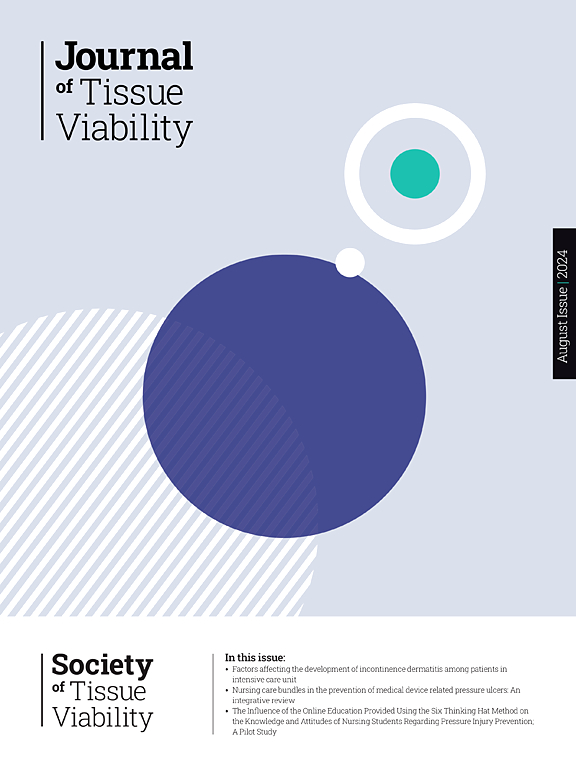跨专业团队在促进压疮预防运动中的角色理解:一项民族志研究
IF 2.4
3区 医学
Q2 DERMATOLOGY
引用次数: 0
摘要
背景跨专业运动促进是预防压疮的关键措施。尽管国际指南强调跨专业合作的重要性,但不同专业团体在运动促进中扮演的具体角色以及他们如何在临床实践中合作仍不清楚。因此,本研究旨在探讨跨专业运动促进的实施情况,以及相关医护人员对跨专业运动促进的理解、角色和期望。方法作为定性快速人种志的一部分,采用观察指南、非正式访谈、现场记录和备忘录等方法,对某急症护理医院预防压疮的临床实践进行观察。采用有目的的抽样,我们纳入了有压疮风险的患者和照顾他们的卫生专业人员,包括护士、物理治疗师和医生。数据分析基于解释性描述。结果我们观察了8例有可能发生褥疮的患者及其亲属和52名护理、理疗和医疗专业人员,共30个观察序列,共80小时。我们发现在运动促进过程的角色认识、管理和控制责任以及患者和亲属的参与方面存在不确定性。相关专业人士都相信跨专业合作的重要性,但我们并没有在实践中观察到相应的实施。结论急诊医院开展压疮预防跨专业运动推广,需要有一个具有约束力的跨医院理念,明确团队组成、角色和合适的沟通渠道,促进交流。本文章由计算机程序翻译,如有差异,请以英文原文为准。
Role understanding of the interprofessional team in promoting movement for pressure ulcer prevention: An ethnographic study
Background
Interprofessional movement promotion is a key measure for preventing pressure ulcers. Although international guidelines emphasize the importance of interprofessional collaboration, it remains unclear what specific roles different professional groups assume in movement promotion and how they collaborate in clinical practice. Therefore, this study aimed to investigate the implementation of interprofessional movement promotion as well as the understanding, roles, and expectations of the involved healthcare professionals.
Methods
As part of qualitative rapid ethnography, we observed the clinical practice of pressure ulcer prevention in an acute care hospital by using an observation guide, informal interviews, field notes, and memos. Using purposive sampling, we included patients at risk of pressure ulcers and the health professionals caring for them, including nurses, physiotherapists, and physicians. The data analysis was based on interpretive description.
Results
We observed 8 patients at risk of decubitus ulcers with relatives and 52 professionals from nursing, physiotherapy, and the medical profession during 30 observation sequences and a total of 80 h. We found uncertainties in the understanding of roles, responsibility for managing and controlling the process of movement promotion, and the involvement of patients and relatives. The involved professionals are convinced of the importance of interprofessional collaboration, but we did not observe corresponding implementation in practice.
Conclusion
The implementation of interprofessional movement promotion for pressure ulcer prevention in acute-care hospitals requires a binding, cross-hospital concept that defines the team composition, roles, and suitable communication channels to promote exchange.
求助全文
通过发布文献求助,成功后即可免费获取论文全文。
去求助
来源期刊

Journal of tissue viability
DERMATOLOGY-NURSING
CiteScore
3.80
自引率
16.00%
发文量
110
审稿时长
>12 weeks
期刊介绍:
The Journal of Tissue Viability is the official publication of the Tissue Viability Society and is a quarterly journal concerned with all aspects of the occurrence and treatment of wounds, ulcers and pressure sores including patient care, pain, nutrition, wound healing, research, prevention, mobility, social problems and management.
The Journal particularly encourages papers covering skin and skin wounds but will consider articles that discuss injury in any tissue. Articles that stress the multi-professional nature of tissue viability are especially welcome. We seek to encourage new authors as well as well-established contributors to the field - one aim of the journal is to enable all participants in tissue viability to share information with colleagues.
 求助内容:
求助内容: 应助结果提醒方式:
应助结果提醒方式:


